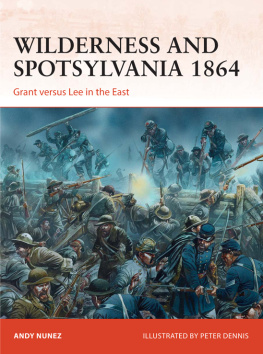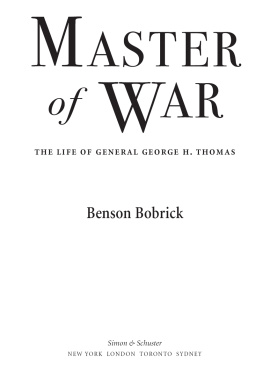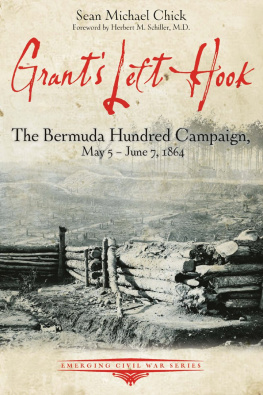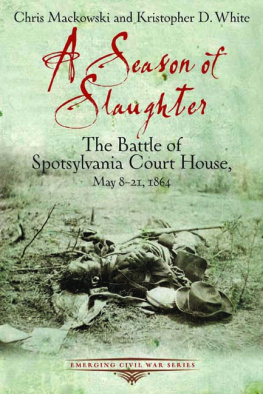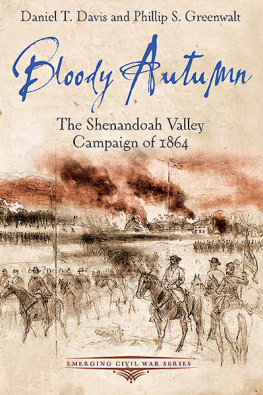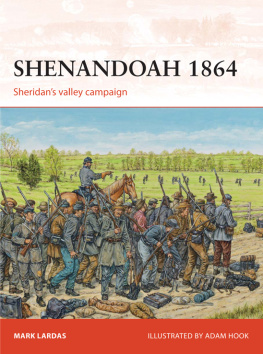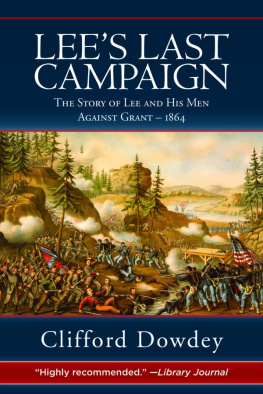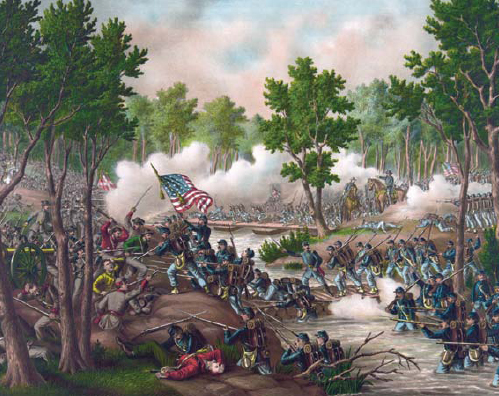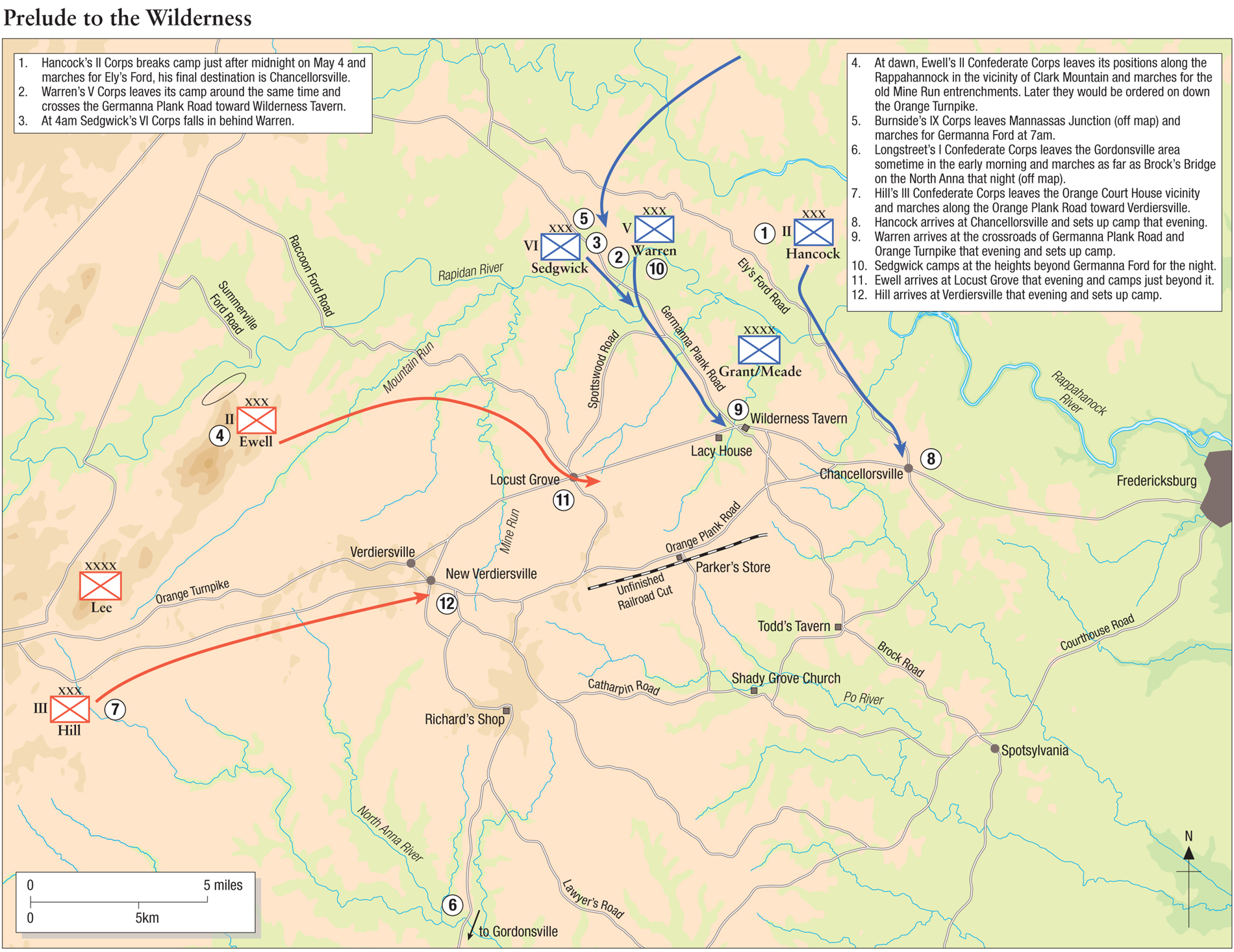CAMPAIGN 267
WILDERNESS AND SPOTSYLVANIA 1864
Grant versus Lee in the East
| ANDY NUNEZ | ILLUSTRATED BY PETER DENNIS |
Series editor Marcus Cowper
CONTENTS
INTRODUCTION
The American Civil War had been raging for three years by May of 1864. In the West, Union forces under Ulysses S. Grant had achieved a string of victories from the fall of Vicksburg to the relief of Chattanooga. In the East, Confederate forces under Robert E. Lee had managed to keep the Union Army of the Potomac at bay, even making forays into Union territory. Lee had been stopped cold at Gettysburg, and retreated back to Virginia, the Army of the Potomac following along.
Union President Abraham Lincoln felt that there would be no ending the war unless Lees army was decisively defeated. He sent for Ulysses S. Grant to come eastward and the events began to come together for the main event of the Civil War. The two most aggressive and successful commanders on both sides would clash in the campaign that would decide the course of the war in the east.
Since mid-1861, Lincoln had run through a large string of commanders for the main eastern army, from Irvin McDowell, George B. McClellan, John Pope, McClellan again, Ambrose Burnside, Fighting Joe Hooker to George Meade. All of them let opportunities slip and lost sight of the real way to shut down the Confederacy: destroy the Army of Northern Virginia. Most saw capturing Richmond as the prize, but few made more than half-hearted attempts to do so. Most of them started with big plans, then got cold feet the closer they got to real battle, or were bewildered by Lees ability to throw away the tactics book and get away with it, like dividing his army at Chancellorsville to take down Joe Hooker.
Grant the bulldog. Former commander of the Army of the Potomac and potential presidential candidate George McClellan cautions President Abraham Lincoln about bringing Lieutenant-General Ulysses S. Grant to the East to defeat Robert E. Lee, but Lincoln was determined to win. (Library of Congress)
Meade faced down Lee at Gettysburg in July 1863, but instead of snapping at his heels, he slowly swept Lee along, as in Lincolns words, like an old woman shooing her geese across a creek. Lee was back in Virginia, rebuilding his army and surely preparing for another advance. Frustrated, Lincoln called for Grant.
CHRONOLOGY
| 1864 |
| May 3 | Grant orders Meade to move the Army of the Potomac across the Rapidan the next morning to march around the right flank of Lees army and head for Richmond, traveling through a dense area known as the Wilderness. |
| May 4 | Just after midnight, units of the Army of the Potomac begin their march, concurrent with offensives in the West and along the James River. Alerted, Lee moves the Army of Northern Virginia, minus Longstreets corps, to meet Grant. |
| May 5 | Units of the US V Corps and the CSA II Corps meet along the Orange Turnpike while further south a cavalry fight begins along the Orange Plank Road, followed by the CSA III Corps which then engages the US II Corps. Both sides dig in, Lee desperately wishing for the arrival of his I Corps, which was camped farther away. |
| May 6 | Grant attempts an offensive all across the front but Confederate resistance is heavy. The US II Corps breaks the outnumbered CSA III Corps with assistance from other US corps. The CSA front is stabilized by the arrival of James Longstreets I Corps which then flanks the US II Corps under Winfield Hancock and almost routs the entire wing of the US forces until Longstreet is wounded and the offensive stops. On the Northern flank, a CSA flanking maneuver under John B. Gordon surprises units of John Sedgwicks VI Corps and routs them, the front only being saved by darkness. Longstreet is replaced by R. H. Anderson. |
| May 7 | Grant decides to disengage his army and move around Lee toward Spotsylvania Courthouse. Lees army quickly wheels and barely gets there in time to keep possession of the vital crossroads in the town. A. P. Hill, of the CSA III Corps falls ill and is replaced by Jubal Early. |
| May 8 | The US V and VI Corps assault the solidifying trench lines of Anderson and Richard Ewell. Grant orders his cavalry commander Philip Sheridan to raid the area between Lees army and Richmond. Lee sends his cavalry commander Jeb Stuart to stop him. |
| May 9 | Sedgwick is killed by a sniper and his corps is given to Horatio Wright. Union troops from the V, VI, II and Ambrose Burnsides IX Corps fail to make any breakthroughs. |
| May 10 | Grant attempts to break the Confederate trench line, especially a salient called the Mule Shoe and nearly succeeds with a division of troops under Emory Upton. The breach is sealed but 1,000 Confederates are taken prisoner. Grant decides to try a larger attack. |
| May 11 | Except for minor actions, the battle is paused while Grant prepares a new assault on the Mule Shoe salient. Jeb Stuart is mortally wounded at the battle of Yellow Tavern. |
| May 12 | The US II Corps sneaks up to the tip of the Mule Shoe under cover of a heavy fog and attacks on a two-division front, capturing over 2,000 prisoners and several cannon. Only a fierce counterattack by John B. Gordon seals the breach. Supporting attacks fail to make headway. Jeb Stuart dies of his wound. |
| May 1314 | Grant maneuvers his V and VI Corps to try to flank Lee, but is hampered by wet weather. |
| May 1517 | Minor actions occur as Grant tries to maneuver to gain a superior position over Lee. |
| May 18 | The US II and VI Corps assault the CSA II Corps to no avail. Grant decides to try to get around Lees right flank. |
| May 19 | The CSA III Corps under Richard Ewell attacks the maneuvering Union Army but gains little except confirmation Grant is disengaging. Grant begins a march toward Richmond once more as Lee scrambles to get in front of him. The battle of Spotsylvania ends. |
OPPOSING COMMANDERS
THE UNITED STATES OF AMERICA
Ulysses Simpson Grant (Commander of the Union Army). Appointed to the newly created rank of lieutenant-general, Ulysses S. Grant would soon find himself Commander in Chief of all Union armies and on a collision course with the Confederacys star general. Grant was not a favorite with many generals, but Lincoln saw in this man a kindred spirit. Grant served in the Mexican War, then resigned his captaincy and went into a series of failed business ventures. When the war started, he managed to get a position thanks to a political friend and his star slowly rose through Shiloh, Vicksburg and Chattanooga. Lincoln called Grant to Washington in early 1864 to take command. A man of action, he soon saw a clear strategy that would win the war, by pressing the Confederacy simultaneously on all fronts. With an overwhelming superiority in men and materiel, he was confident of victory.
Next page
